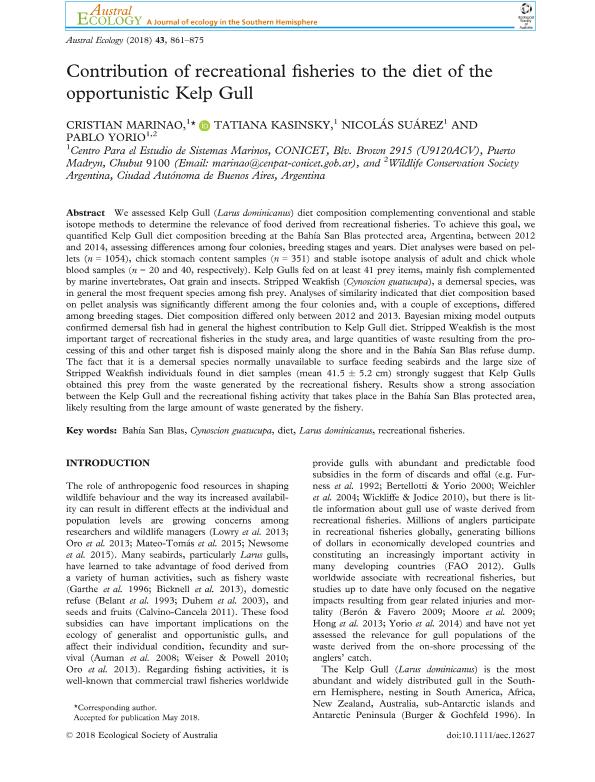Mostrar el registro sencillo del ítem
dc.contributor.author
Marinao, Cristian Javier

dc.contributor.author
Kasinsky Aguilera, Lorna Tatiana

dc.contributor.author
Suárez, Nicolás

dc.contributor.author
Yorio, Pablo Martin

dc.date.available
2019-11-07T21:48:56Z
dc.date.issued
2018-12
dc.identifier.citation
Marinao, Cristian Javier; Kasinsky Aguilera, Lorna Tatiana; Suárez, Nicolás; Yorio, Pablo Martin; Contribution of recreational fisheries to the diet of the opportunistic Kelp Gull; Wiley Blackwell Publishing, Inc; Austral Ecology; 43; 8; 12-2018; 861-875
dc.identifier.issn
1442-9985
dc.identifier.uri
http://hdl.handle.net/11336/88280
dc.description.abstract
We assessed Kelp Gull (Larus dominicanus) diet composition complementing conventional and stable isotope methods to determine the relevance of food derived from recreational fisheries. To achieve this goal, we quantified Kelp Gull diet composition breeding at the Bahía San Blas protected area, Argentina, between 2012 and 2014, assessing differences among four colonies, breeding stages and years. Diet analyses were based on pellets (n = 1054), chick stomach content samples (n = 351) and stable isotope analysis of adult and chick whole blood samples (n = 20 and 40, respectively). Kelp Gulls fed on at least 41 prey items, mainly fish complemented by marine invertebrates, Oat grain and insects. Stripped Weakfish (Cynoscion guatucupa), a demersal species, was in general the most frequent species among fish prey. Analyses of similarity indicated that diet composition based on pellet analysis was significantly different among the four colonies and, with a couple of exceptions, differed among breeding stages. Diet composition differed only between 2012 and 2013. Bayesian mixing model outputs confirmed demersal fish had in general the highest contribution to Kelp Gull diet. Stripped Weakfish is the most important target of recreational fisheries in the study area, and large quantities of waste resulting from the processing of this and other target fish is disposed mainly along the shore and in the Bahía San Blas refuse dump. The fact that it is a demersal species normally unavailable to surface feeding seabirds and the large size of Stripped Weakfish individuals found in diet samples (mean 41.5 ± 5.2 cm) strongly suggest that Kelp Gulls obtained this prey from the waste generated by the recreational fishery. Results show a strong association between the Kelp Gull and the recreational fishing activity that takes place in the Bahía San Blas protected area, likely resulting from the large amount of waste generated by the fishery.
dc.format
application/pdf
dc.language.iso
eng
dc.publisher
Wiley Blackwell Publishing, Inc

dc.rights
info:eu-repo/semantics/openAccess
dc.rights.uri
https://creativecommons.org/licenses/by-nc-sa/2.5/ar/
dc.subject
Bah ıa San Blas
dc.subject
Cynoscion guatucupa
dc.subject
Diet
dc.subject
Larus dominicanus
dc.subject
recreational fisheries
dc.subject.classification
Zoología, Ornitología, Entomología, Etología

dc.subject.classification
Ciencias Biológicas

dc.subject.classification
CIENCIAS NATURALES Y EXACTAS

dc.title
Contribution of recreational fisheries to the diet of the opportunistic Kelp Gull
dc.type
info:eu-repo/semantics/article
dc.type
info:ar-repo/semantics/artículo
dc.type
info:eu-repo/semantics/publishedVersion
dc.date.updated
2019-10-22T15:35:18Z
dc.journal.volume
43
dc.journal.number
8
dc.journal.pagination
861-875
dc.journal.pais
Reino Unido

dc.journal.ciudad
Londres
dc.description.fil
Fil: Marinao, Cristian Javier. Consejo Nacional de Investigaciones Científicas y Técnicas. Centro Científico Tecnológico Conicet - Centro Nacional Patagónico. Centro para el Estudio de Sistemas Marinos; Argentina
dc.description.fil
Fil: Kasinsky Aguilera, Lorna Tatiana. Consejo Nacional de Investigaciones Científicas y Técnicas. Centro Científico Tecnológico Conicet - Centro Nacional Patagónico. Centro para el Estudio de Sistemas Marinos; Argentina
dc.description.fil
Fil: Suárez, Nicolás. Consejo Nacional de Investigaciones Científicas y Técnicas. Centro Científico Tecnológico Conicet - Centro Nacional Patagónico. Centro para el Estudio de Sistemas Marinos; Argentina
dc.description.fil
Fil: Yorio, Pablo Martin. Consejo Nacional de Investigaciones Científicas y Técnicas. Centro Científico Tecnológico Conicet - Centro Nacional Patagónico. Centro para el Estudio de Sistemas Marinos; Argentina. Wildlife Conservation Society Argentina; Argentina
dc.journal.title
Austral Ecology

dc.relation.alternativeid
info:eu-repo/semantics/altIdentifier/url/https://onlinelibrary.wiley.com/doi/abs/10.1111/aec.12627
dc.relation.alternativeid
info:eu-repo/semantics/altIdentifier/doi/http://dx.doi.org/10.1111/aec.12627
Archivos asociados
